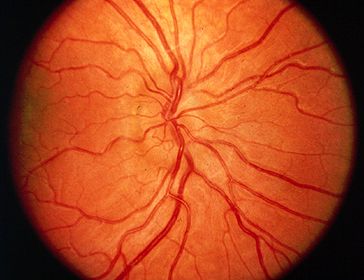Vitreopapillary traction. Note the mild peripheral obscuration of retinal vessels in both eyes with relative preservation of the optic disc margins.
Optical coherence tomography of vitreopapillary traction (same patient). Bilateral vitreopapillary traction noted.
Fluorescein angiography of vitreopapillary traction (same patient). Note the mild focal leakage seen in both eyes (perhaps slightly more prominent in the left eye).
Image credit: Houle E, Miller NR. Bilateral vitreopapillary traction demonstrated by optical coherence tomography mistaken for papilledema. Case Rep Ophthalmol Med 2012;2012:682659. doi: 10.1155/2012/682659. Available online. Used for educational purposes.




























